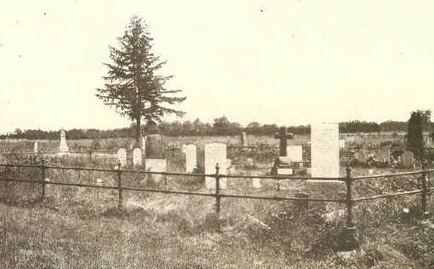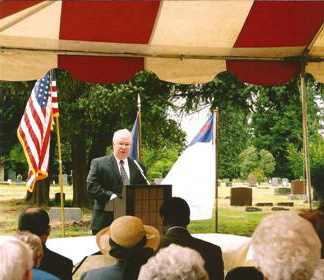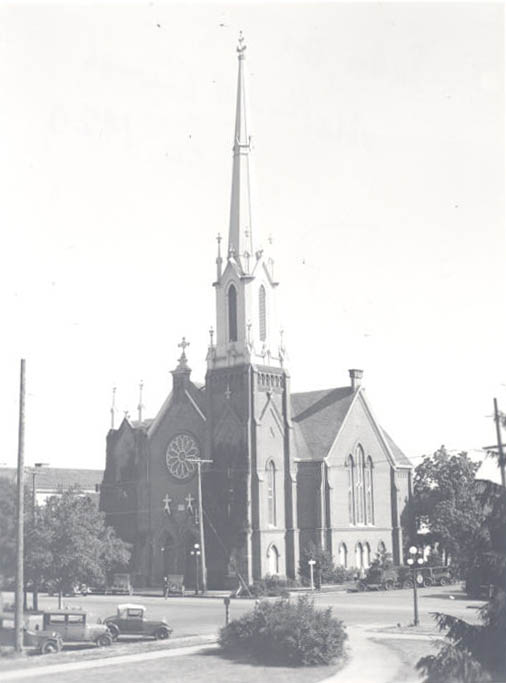Lee Mission Cemetery on D Street in northeast Salem was formally constituted in 1869 on 4.77 acres of land deeded by former Methodist missionary Reverend Josiah Parrish and his wife Elizabeth Winn Parrish. Additional parcels were deeded in 1887 and 1890. With its present size of 15.67 acres and estimated 3,200 burials, the still-active cemetery is the final resting place of a sizable concentration of missionaries, clergymen, educators, and lay leaders of the Methodist Episcopal Church on the West Coast. In recognition of this distinction, in 1978 it became one of the first cemeteries in Oregon to be listed in the National Register of Historic Places.
The Reverend Jason Lee founded the first mission to Native peoples of the Pacific Northwest on bottomlands adjacent to the Willamette River north of Salem in 1834. As the Methodist mission expanded with successive reinforcements, Lee moved the central station of his regional network of missionary outposts to Chemeketa (present-day Salem) in 1841.
The mission’s active period came to an end several years later, after Lee was recalled from his post. In the expectation of returning to Oregon, Lee departed for the East, leaving Lucy Anna, his motherless and only surviving child, in the care of Reverend Gustavus Hines, the preacher in charge of the central station. In broken health, Lee died and was buried in 1845 in his hometown of Stanstead, Lower Canada, on Vermont’s border with Quebec.
The Missionary Society of the Methodist Episcopal Church sent others to dispose of the mission’s assets and to organize circuits in the Oregon country. As soon as a community burial ground was formally established on the Parrish claim, members of the mission who had been buried at the old mission site and elsewhere were re-interred in the fenced precinct known as the Diamond Square. Among the re-interred were Jason Lee’s first wife, Ann Maria Pittman Lee, and her infant son; mission schoolteacher Cyrus Shepard; and Lee’s second wife, Lucy Thompson Lee, mother of Lucy Anna. In time, Lucy Anna Maria Lee Grubbs, a Willamette University graduate and teacher, was buried there as well.
The Diamond Square also contains the graves of the Parrishes, Gustavus and Lydia Bryant Hines (Lucy Anna’s foster parents), and Alanson Beers, the mission’s blacksmith and farm superintendent. Through the initiative of the Columbia District Conference, Jason Lee’s remains and original tombstone of Vermont marble were placed among the graves of his mission family. Elaborate re-interment ceremonies were carried out in Salem in 1906 under the auspices of the Methodist Episcopal Church.
The cemetery is in a mostly open, parklike setting, shaded by mature conifers and deciduous trees across the southern section. Its gridiron plat is bisected north to south by a central drive from D Street, which leads to the special precinct of missionary graves. The cemetery’s nineteenth-century grave markers include marble tablets, tapered shafts, and stacked granite shaft monuments terminating in caps with urn finials. A pair of stately brick pillars marked the main entrance in the 1920s. In 1941, an iron gateway arch was added bearing the cemetery title crested with a cut-out date of 1838, referring to the first death among personnel at the original mission site, that of Lee’s first wife.
Since 1964, the cemetery has been held and maintained by the independent nonprofit corporation known as Lee Mission Cemetery. Proceeds from the sale of burial lots in reserve tracts help support maintenance operations.
Of fifty-three Methodist clergymen interred in the cemetery, notable among the early figures are William Roberts, the last mission superintendent and organizer of the Oregon and California Mission Conference of the Methodist Episcopal Church, and James H. Wilbur, organizer of Methodist churches and academies in Oregon City, Portland, and the Umpqua region. The interred include preacher-theologian Nehemiah Doane and Reverend Harvey K. Hines, editor of the Pacific Christian Advocate and professor of theology at Willamette University. Reverend Alvan F. Waller, agent for the construction of Willamette University’s University Hall (Waller Hall), is interred in the cemetery’s only vault. A prominent monument marks the grave of Erastus O. Haven, thirty-fifth bishop of the Methodist Episcopal Church, who died at Salem in 1881.
-
![Main entrance gateway at 2104 D Street NE, Salem.]()
Lee Mission Cemetery, gate.
Main entrance gateway at 2104 D Street NE, Salem. Photo James Momyer, copyright Lee Mission Cemetery
-
![Graves of Jason Lee and Methodist mission members in Diamond Square, about 1906.]()
Lee Mission Cemetery, Jason Lee grave, ca. 1906.
Graves of Jason Lee and Methodist mission members in Diamond Square, about 1906. In Francis H. Grubbs, comp., Memorial Services at Reinterment of Remains of Rev. Jason Lee, Salem, Oregon, June 15, 1906
-
![Cemetery Board Chair James Momyer with commemorative plaque.]()
Lee Mission Cemetery, sign.
Cemetery Board Chair James Momyer with commemorative plaque. E. Walton Potter, copyright Lee Mission Cemetery
-
![Grave markers of Jason Lee and family in cemetery's Diamond Square.]()
Lee Mission Cemetery, grave markers 1.
Grave markers of Jason Lee and family in cemetery's Diamond Square. Photo E. Walton Potter, copyright Lee Mission Cemetery
-
![Grave markers of Jason Lee and family in cemetery's Diamond Square.]()
Lee Mission Cemetery, grave markers 2.
Grave markers of Jason Lee and family in cemetery's Diamond Square. Photo E. Walton Potter, copyright Lee Mission Cemetery
-
![Diamond Square graves of Josiah Parrish (r) and Rev. Gustavus Hines (far left).]()
Lee Mission Cemetery, grave markers 3.
Diamond Square graves of Josiah Parrish (r) and Rev. Gustavus Hines (far left). Photo E. Walton Potter, copyright Lee Mission Cemetery
-
![Joint grave monument of Rev. William Roberts and Rev. J. H. Wilbur and their wives.]()
Lee Mission Cemetery, Wilbur grave marker.
Joint grave monument of Rev. William Roberts and Rev. J. H. Wilbur and their wives. Photo E. Walton Potter, copyright Lee Mission Cemetery
-
![Bob Speckman speaking at centennial of return of Jason Lee's remains, June 18, 2006.]()
Lee Mission Cemetery, centennial, June 18 2006.
Bob Speckman speaking at centennial of return of Jason Lee's remains, June 18, 2006. Photo E. Walton Potter, copyright Lee Mission Cemetery
Related Entries
-
![Alvan Waller (1808-1872)]()
Alvan Waller (1808-1872)
In most histories of Oregon, Alvan Waller appears most prominently as t…
-
![First Methodist Church (Salem)]()
First Methodist Church (Salem)
Founded in 1841 by Jason Lee and members of the Methodist Episcopal Chu…
-
![Jason Lee (1803-1845)]()
Jason Lee (1803-1845)
Few names in the history of early nineteenth-century Oregon are better …
Map This on the Oregon History WayFinder
The Oregon History Wayfinder is an interactive map that identifies significant places, people, and events in Oregon history.
Further Reading
Lee Mission Cemetery. http://www.oregonpioneers.com/marion/LeeCem.htm.











